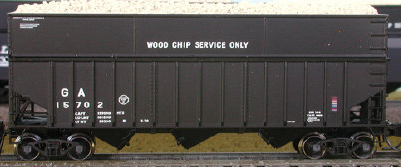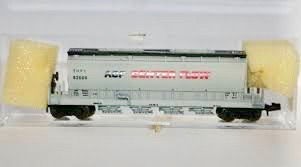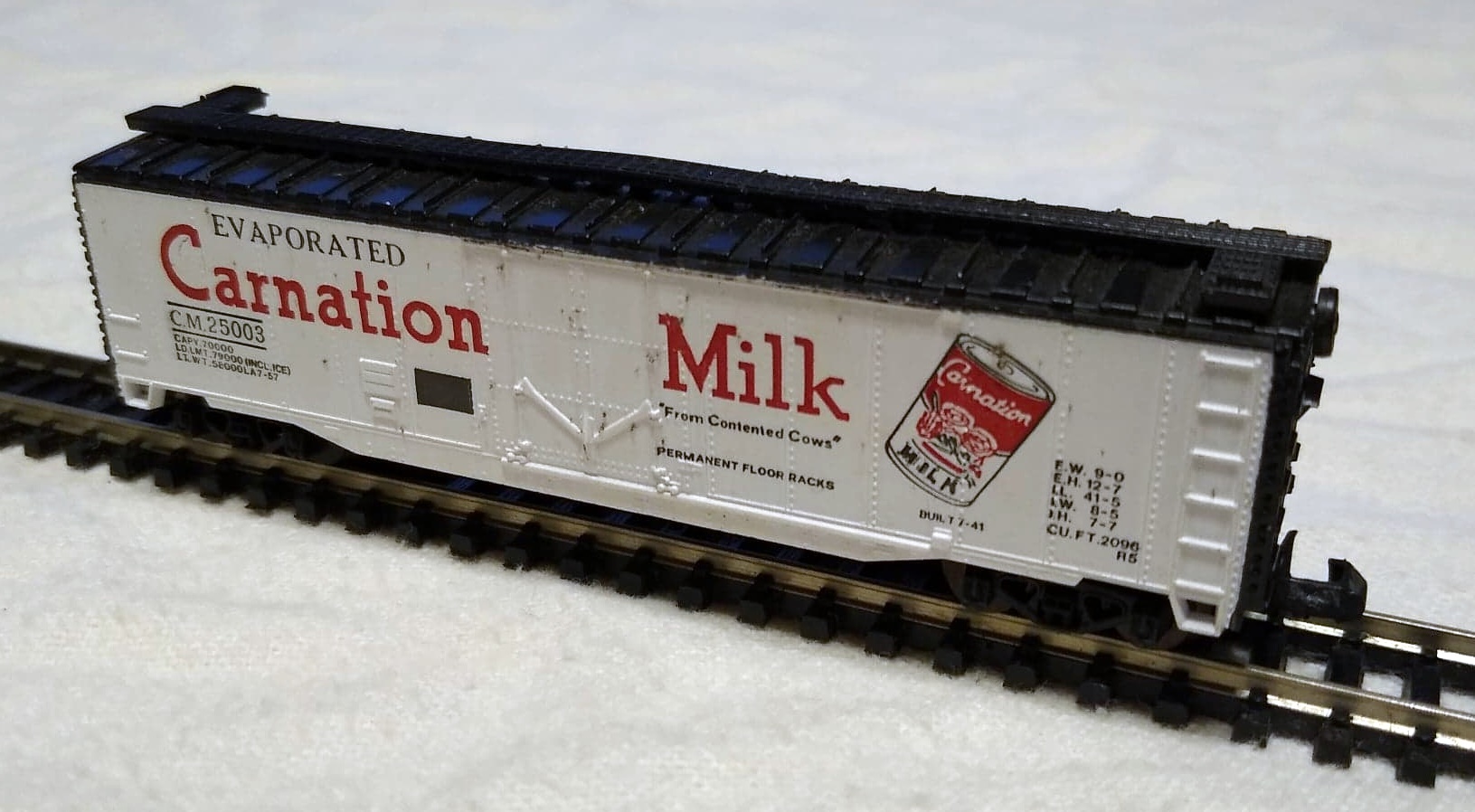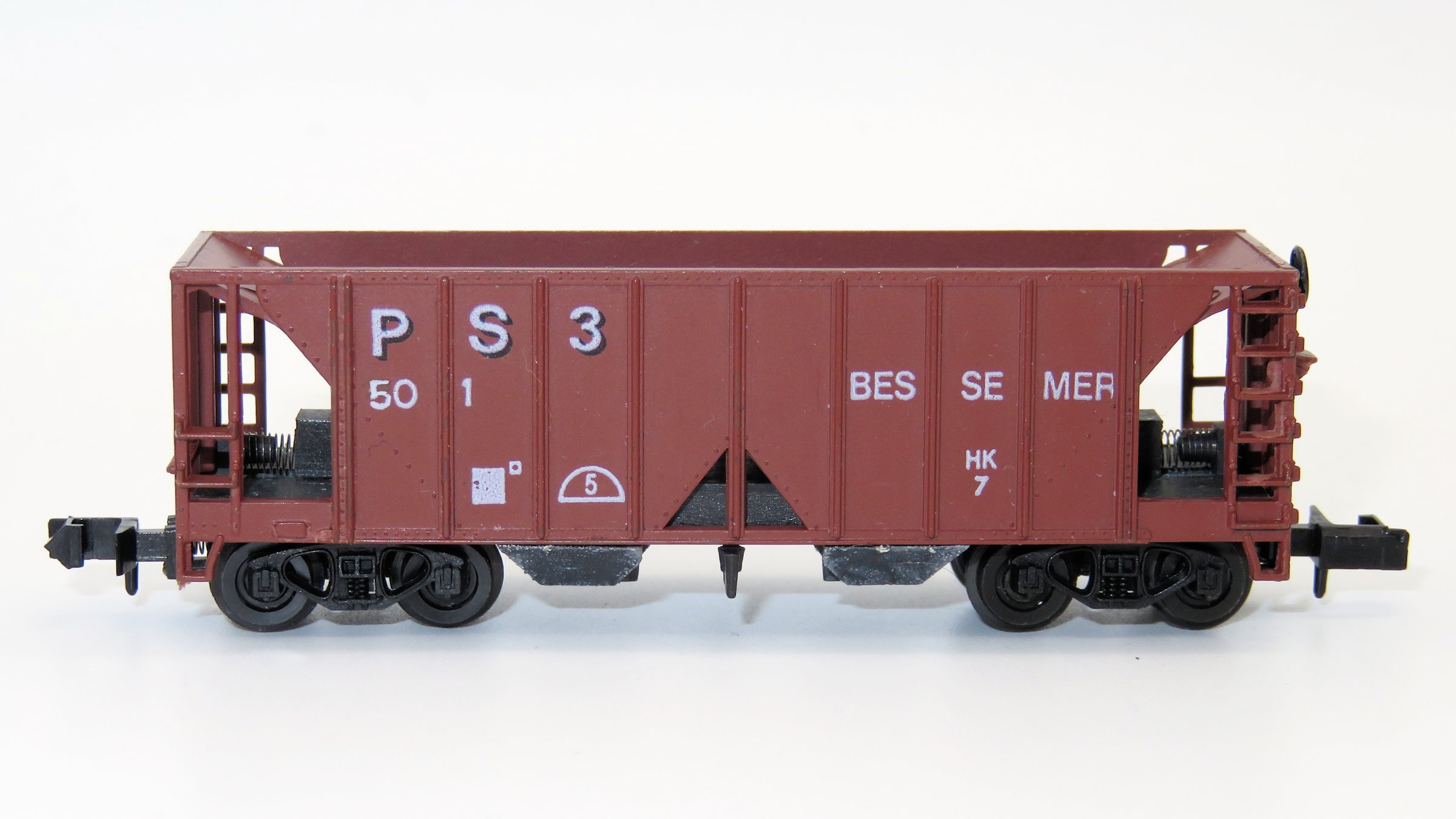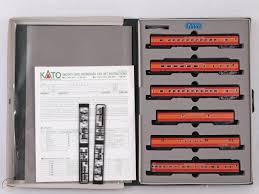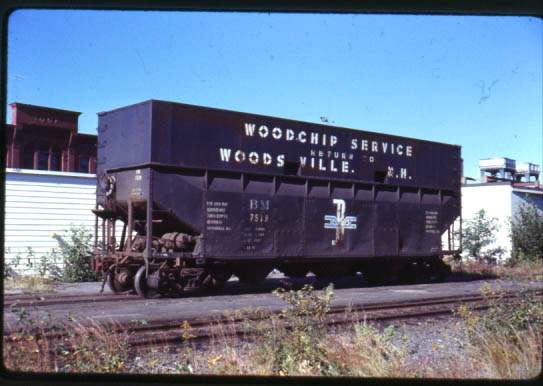Prototype History: As the timber industry discovered new uses for wood chips (they had been burning them as waste,) the railroad industry hurried to develop a means to haul them economically. By adding extension boards to standard 70 ton coal hoppers, many roads were able to take on this traffic. Some railroads preferred flat side extensions made from steel or composite (steel and plywood) while others preferred rib-sided extensions.
In New England in the 1950s-1970s a very common car on the B&M system were the "Woodsville hoppers". They were basically B&M 70 ton hopper cars slightly modified for wood chip service and were based out of Woodsville, NH. They could be seen everywhere from Portland on the Maine Central system to Southern Connecticut on the New Haven.
In New England in the 1950s-1970s a very common car on the B&M system were the "Woodsville hoppers". They were basically B&M 70 ton hopper cars slightly modified for wood chip service and were based out of Woodsville, NH. They could be seen everywhere from Portland on the Maine Central system to Southern Connecticut on the New Haven.
Road Name History: 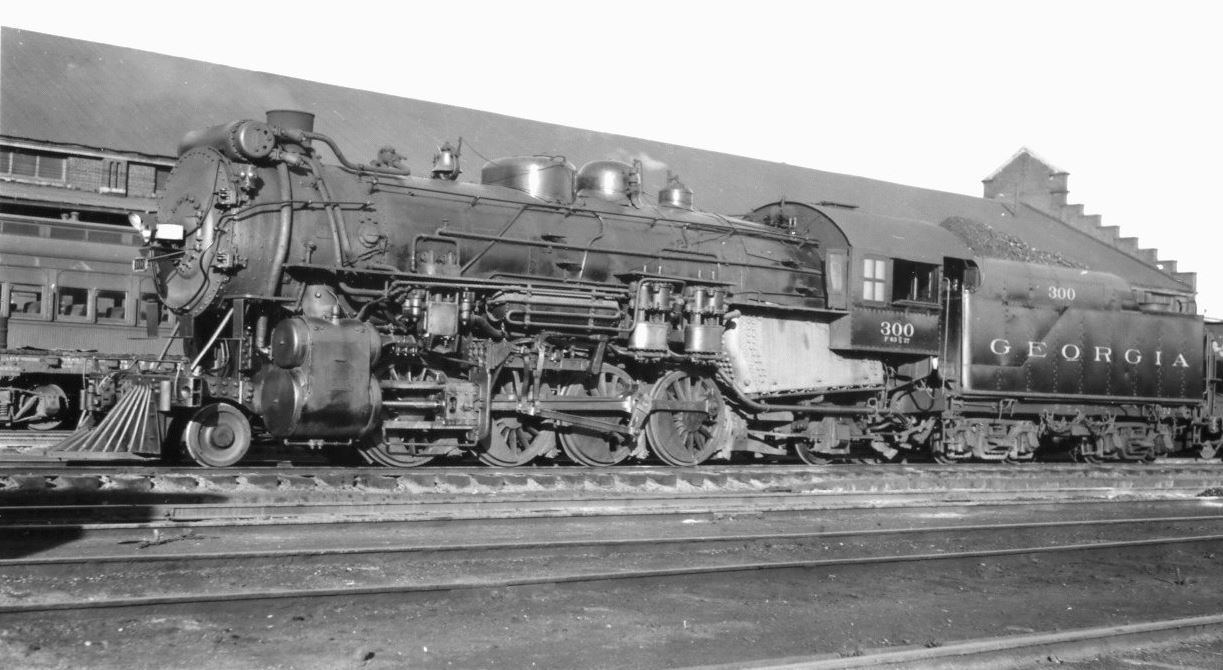 As with the Clinchfield, for most of its history the Georgia Railroad existed as a non-incorporated company operating the railroad property of the Georgia Railroad & Banking Company on behalf of Louisville & Nashville and Atlantic Coast Line. In turn, the Georgia controlled the two West Point Route railroads. The Georgia Railroad & Banking Company was established in 1833. The 329 mile line is Y shaped with Augusta on the east end, and Atlanta and Macon in the west, plus a trio of branches on the Atlanta leg. The Georgia had been built to 5’ gauge like most lines in the South. It was standard gauged in 1886.
As with the Clinchfield, for most of its history the Georgia Railroad existed as a non-incorporated company operating the railroad property of the Georgia Railroad & Banking Company on behalf of Louisville & Nashville and Atlantic Coast Line. In turn, the Georgia controlled the two West Point Route railroads. The Georgia Railroad & Banking Company was established in 1833. The 329 mile line is Y shaped with Augusta on the east end, and Atlanta and Macon in the west, plus a trio of branches on the Atlanta leg. The Georgia had been built to 5’ gauge like most lines in the South. It was standard gauged in 1886.
The big power in the days of steam were Mikados and Pacifics. Some of the Mikes were picked up second hand from New York Central and Clinchfield. Motive power from the West Point Route roads was frequently seen on the Georgia and vice versa. The Georgia dieselized fairly early with EMD and Baldwin switchers, F units and geeps (set up to run short-hood-forward like their parents) in a nice blue with silver band paint scheme also used on the West Point Route. In the 60’s, they dropped the silver band and by the time their GP40s arrived they had switched to black with white lettering and frame stripes. The diesel fleet hovered around 30 units. The last locomotives delivered to Georgia were GP38-2’s in the late 70s and they arrived in Family Lines gray.
Passenger service on the Georgia had always been a modest affair and during the 60s had dwindled to just mixed trains. When Amtrak appeared, Georgia opted out, instead continuing to run the mixed trains until 1983. This was because in Georgia Railroad & Banking Company’s original charter in 1833 the line was exempted from state and local taxes with the exception of a modest tax on net profits. In return, the company was to supply passenger service on its routes in perpetuity. During the 1970s, the “super-mixed” trains often consisted of 3 diesels, 50 or so freight cars, a streamlined coach, and a caboose and they would switch industries and stop (the coach) at depots along the way.
In 1983, the Seaboard Coast Line and Louisville & Nashville merged to form Seaboard System. As such, there was no longer a reason to have their two unincorporated lines, Georgia and Clinchfield, as separate entities and they were merged into Seaboard System along with the West Point Route roads. The mixed train operation ended less than 4 months after the merger.

The big power in the days of steam were Mikados and Pacifics. Some of the Mikes were picked up second hand from New York Central and Clinchfield. Motive power from the West Point Route roads was frequently seen on the Georgia and vice versa. The Georgia dieselized fairly early with EMD and Baldwin switchers, F units and geeps (set up to run short-hood-forward like their parents) in a nice blue with silver band paint scheme also used on the West Point Route. In the 60’s, they dropped the silver band and by the time their GP40s arrived they had switched to black with white lettering and frame stripes. The diesel fleet hovered around 30 units. The last locomotives delivered to Georgia were GP38-2’s in the late 70s and they arrived in Family Lines gray.
Passenger service on the Georgia had always been a modest affair and during the 60s had dwindled to just mixed trains. When Amtrak appeared, Georgia opted out, instead continuing to run the mixed trains until 1983. This was because in Georgia Railroad & Banking Company’s original charter in 1833 the line was exempted from state and local taxes with the exception of a modest tax on net profits. In return, the company was to supply passenger service on its routes in perpetuity. During the 1970s, the “super-mixed” trains often consisted of 3 diesels, 50 or so freight cars, a streamlined coach, and a caboose and they would switch industries and stop (the coach) at depots along the way.
In 1983, the Seaboard Coast Line and Louisville & Nashville merged to form Seaboard System. As such, there was no longer a reason to have their two unincorporated lines, Georgia and Clinchfield, as separate entities and they were merged into Seaboard System along with the West Point Route roads. The mixed train operation ended less than 4 months after the merger.
Brand/Importer Information: Bluford Shops began in 2007 as a side project of two model railroad industry veterans, Craig Ross and Steve Rodgers. They saw a gap between road names available on N scale locomotives but not available on cabooses. They commissioned special runs of Atlas cabooses in Atlantic Coast Line, Central of Georgia, Monon, Boston & Maine and Southern plus runs on Grand Trunk Western and Central Vermont on the MDC wooden cabooses. While these were in process, they began to develop their first all new tooling project, 86' Auto Parts Boxcars in double door and quad door editions in N scale. By January of 2008, Bluford Shops became a full time venture. Along with additional N scale freight cars and their own tooling for new cabooses, they have brought their own caboose line to HO scale. They also have their popular Cornfields in both HO and N. The future looks bright as they continue to develop new products for your railroad.
The town of Bluford in southern Illinois featured a small yard on Illinois Central's Edgewood Cutoff (currently part of CN.) The yard included a roundhouse, concrete coaling tower (which still stands) and large ice house. Reefer trains running between the Gulf Coast and Chicago were re-iced in Bluford. Things are more quiet now in Bluford with the remaining tracks in the yard used to stage hoppers for mines to the south and store covered hoppers. Intersecting the IC line in Bluford is Southern Railway's (currently NS) line between Louisville and St. Louis. Traffic on this single track line remains relatively heavy.
The town of Bluford in southern Illinois featured a small yard on Illinois Central's Edgewood Cutoff (currently part of CN.) The yard included a roundhouse, concrete coaling tower (which still stands) and large ice house. Reefer trains running between the Gulf Coast and Chicago were re-iced in Bluford. Things are more quiet now in Bluford with the remaining tracks in the yard used to stage hoppers for mines to the south and store covered hoppers. Intersecting the IC line in Bluford is Southern Railway's (currently NS) line between Louisville and St. Louis. Traffic on this single track line remains relatively heavy.
Item created by: CNW400 on 2019-12-18 08:49:49. Last edited by CNW400 on 2020-05-21 09:00:16
If you see errors or missing data in this entry, please feel free to log in and edit it. Anyone with a Gmail account can log in instantly.
If you see errors or missing data in this entry, please feel free to log in and edit it. Anyone with a Gmail account can log in instantly.


